|
One of many nice things about autumn at Hilton Pond Center--along with the fact that the mosquito population is diminishing by the day--is that we get to to see fruits of the photosynthetic labor of our local flora. Oak trees are dropping acorns right and left, various wild asters are dispersing their windborne seeds on fluffy sails, and Carolina Moonseed vines are forming tight clusters of plump, scarlet berries that brighten the cloudiest days.
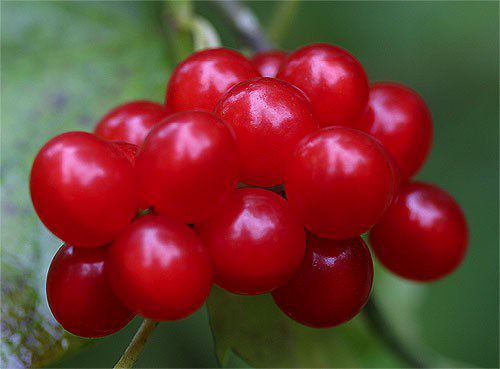 All text & photos © Hilton Pond Center
All text & photos © Hilton Pond Center
Carolina Moonseed--also called Coralbeads--is a native plant often overlooked by naturalists and gardeners alike. Found throughout much of the southeastern U.S. except at higher elevations, it is a semi-woody vine with twining stems that can reach ten feet tall and an inch in diameter in areas where frost dieback doesn't occur. 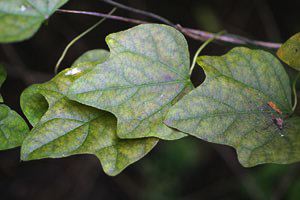 Most plants are considerably smaller, with skinny eighth-inch stems that twist through thickets of Trumpet Creeper or among the shrubs and saplings that populate old fencerows and shaded woods. Usually deciduous across the Carolinas, Carolina Moonseed can hold its foliage year-round in Florida and the Gulf Coast states. Its dark green, five-inch leaves (which are beginning to yellow in the photos above right and page bottom) are heart-shaped or slightly lobed, shiny above, moderately fuzzy beneath, and with long petioles. In summer, Carolina Moonseed may be browsed by White-tailed Deer and even by domesticated goats and cattle. Most plants are considerably smaller, with skinny eighth-inch stems that twist through thickets of Trumpet Creeper or among the shrubs and saplings that populate old fencerows and shaded woods. Usually deciduous across the Carolinas, Carolina Moonseed can hold its foliage year-round in Florida and the Gulf Coast states. Its dark green, five-inch leaves (which are beginning to yellow in the photos above right and page bottom) are heart-shaped or slightly lobed, shiny above, moderately fuzzy beneath, and with long petioles. In summer, Carolina Moonseed may be browsed by White-tailed Deer and even by domesticated goats and cattle.
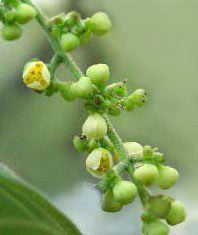 Appearing June through August, the inconspicuous green and yellow blossoms of Carolina Moonseed (left) are only a quarter-inch across and--like the fruit they produce--occur in clusters, or panicles. Male panicles are up to 6" long, while female clusters--borne on separate plants--are much shorter. Although the flowers aren't at all showy, the leaves and fruit of Carolina Moonseed make the plant worth considering as a trellis or arbor vine for the wildlife garden. It can be grown from seed--three months of cold stratification is a requirment--or from stem cuttings, but most of the time Carolina Moonseed just "volunteers" after its fruit has been eaten and deposited by birds or small mammals. Appearing June through August, the inconspicuous green and yellow blossoms of Carolina Moonseed (left) are only a quarter-inch across and--like the fruit they produce--occur in clusters, or panicles. Male panicles are up to 6" long, while female clusters--borne on separate plants--are much shorter. Although the flowers aren't at all showy, the leaves and fruit of Carolina Moonseed make the plant worth considering as a trellis or arbor vine for the wildlife garden. It can be grown from seed--three months of cold stratification is a requirment--or from stem cuttings, but most of the time Carolina Moonseed just "volunteers" after its fruit has been eaten and deposited by birds or small mammals.
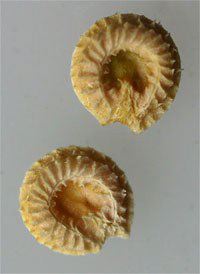 Classified in the Menispermaceae (Moonseed Family), Carolina Moonseed's scientific name is Cocculus carolinus, or "little berry from Carolina," but this epithet fails to reveal the source of its common name. To learn the secret, simply pluck one of the ripe, nearly translucent berries and remove the scarlet skin and colorless pulp. What remains is a flat, off-white, dimpled, quarter-inch seed that somewhat resembles a crescent moon (right). Actually, Carolina Moonseed's closest relative--Canada Moonseed, Menispermum canadense--has a seed more moon-like; the Carolina Moonseed looks like a snail to some observers--hence its second alternate name of Carolina Snailseed. Classified in the Menispermaceae (Moonseed Family), Carolina Moonseed's scientific name is Cocculus carolinus, or "little berry from Carolina," but this epithet fails to reveal the source of its common name. To learn the secret, simply pluck one of the ripe, nearly translucent berries and remove the scarlet skin and colorless pulp. What remains is a flat, off-white, dimpled, quarter-inch seed that somewhat resembles a crescent moon (right). Actually, Carolina Moonseed's closest relative--Canada Moonseed, Menispermum canadense--has a seed more moon-like; the Carolina Moonseed looks like a snail to some observers--hence its second alternate name of Carolina Snailseed.
After dissecting the fruit, don't lick your fingers. The alkaloid compounds in Carolina Moonseeds are very bitter and can cause gastric distress. Even so, eating the fruit is not known to be fatal to humans--which is sometimes the case with the bluish-black berry of Canada Moonseed. The latter species has a more northerly distrubution, including much of North Carolina and the border counties of South Carolina.
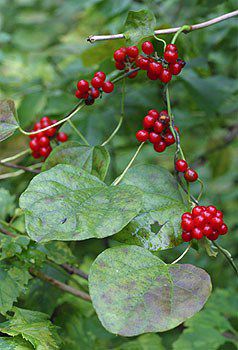 Books about creating backyard habitats frequently praise Carolina Moonseed as a plant whose berries are relished by many species of birds. This is probably true, but here at Hilton Pond Center our vines are still laden with fruit--even though berry-loving birds such as Northern Cardinals, White-throated Sparrows, and Northern Mockingbirds are around in good numbers. Perhaps other wild foods are still abundant at this time of year--we haven't yet run out of Pokeweed berries, for example--or maybe the birds are just waiting for those unpalatable alkaloids to moderate in intensity. Regardless, if this year is like most, the Carolina Moonseed berries will be gone by Christmas--a good sign that they must have at least some nutritional value. Whether birds eat them or not, we're just happy to have these bright red berries at Hilton Pond Center so we can pop them open and show visitors how Coralbeads/Carolina Moonseed/Carolina Snailseed actually got its name(s). Books about creating backyard habitats frequently praise Carolina Moonseed as a plant whose berries are relished by many species of birds. This is probably true, but here at Hilton Pond Center our vines are still laden with fruit--even though berry-loving birds such as Northern Cardinals, White-throated Sparrows, and Northern Mockingbirds are around in good numbers. Perhaps other wild foods are still abundant at this time of year--we haven't yet run out of Pokeweed berries, for example--or maybe the birds are just waiting for those unpalatable alkaloids to moderate in intensity. Regardless, if this year is like most, the Carolina Moonseed berries will be gone by Christmas--a good sign that they must have at least some nutritional value. Whether birds eat them or not, we're just happy to have these bright red berries at Hilton Pond Center so we can pop them open and show visitors how Coralbeads/Carolina Moonseed/Carolina Snailseed actually got its name(s).
All text & photos © Hilton Pond Center
RESULTS OF THE "FIRST FUN FUNGI QUIZ"
After an amiable exchange of e-mail rebuttals with entrants in the First Fun Fungi Quiz from two weeks ago, we're ready to announce our final decision on the answers and name the winner.
- 1. Scarlet Waxy Cap, Hygrophorus coccineus (There was some debate about whether the mushroom in the photo is actually H. reai, which we wanted it to be but ruled out because it has never been reported from the Southeast. We'd be happy to reconsider on this one.)
- 2. Tawny Grisette, Amanita fulva
- 3. Honey Fungus, Armillariella (Armillaria) mellea (This mushroom complex has been split into several species, so a variety of answers could be acceptable.)
- 4. Old Man of the Woods, Stroblomyces floccopus
- 5. Scarlet Waxy Cap, Hygrophorus coccineus
- 6. Fetid False Coral, Thelephora palmata
The prize--our highly coveted Operation RubyThroat T-shirt--for the most correct and elaborate answers goes to Bill Yule of Guilford, Connecticut USA, who had four of the IDs correct. (Bill is graciously donating his prize to a promising young student with an interest in mycology.)
Thanks to everyone who entered this admittedly difficult contest. Next time we'll try to include photos from several angles and provide a few more hints!
If you enjoy "This Week at Hilton Pond," please help Support
Hilton Pond Center for Piedmont Natural History.
It's painless, and YOU can make a difference!
You may wish to consult our Index of all nature topics covered since February 2000.
For a free, non-fattening, on-line subscription to "This Week at Hilton Pond," just send an e-mail with "Subscribe" in the subject line to THIS WEEK
|


 Most plants are considerably smaller, with skinny eighth-inch stems that twist through thickets of Trumpet Creeper or among the shrubs and saplings that populate old fencerows and shaded woods. Usually deciduous across the Carolinas, Carolina Moonseed can hold its foliage year-round in Florida and the Gulf Coast states. Its dark green, five-inch leaves (which are beginning to yellow in the photos above right and page bottom) are heart-shaped or slightly lobed, shiny above, moderately fuzzy beneath, and with long petioles. In summer, Carolina Moonseed may be browsed by White-tailed Deer and even by domesticated goats and cattle.
Most plants are considerably smaller, with skinny eighth-inch stems that twist through thickets of Trumpet Creeper or among the shrubs and saplings that populate old fencerows and shaded woods. Usually deciduous across the Carolinas, Carolina Moonseed can hold its foliage year-round in Florida and the Gulf Coast states. Its dark green, five-inch leaves (which are beginning to yellow in the photos above right and page bottom) are heart-shaped or slightly lobed, shiny above, moderately fuzzy beneath, and with long petioles. In summer, Carolina Moonseed may be browsed by White-tailed Deer and even by domesticated goats and cattle. Appearing June through August, the inconspicuous green and yellow blossoms of Carolina Moonseed (left) are only a quarter-inch across and--like the fruit they produce--occur in clusters, or panicles. Male panicles are up to 6" long, while female clusters--borne on separate plants--are much shorter. Although the flowers aren't at all showy, the leaves and fruit of Carolina Moonseed make the plant worth considering as a trellis or arbor vine for the wildlife garden. It can be grown from seed--three months of cold stratification is a requirment--or from stem cuttings, but most of the time Carolina Moonseed just "volunteers" after its fruit has been eaten and deposited by birds or small mammals.
Appearing June through August, the inconspicuous green and yellow blossoms of Carolina Moonseed (left) are only a quarter-inch across and--like the fruit they produce--occur in clusters, or panicles. Male panicles are up to 6" long, while female clusters--borne on separate plants--are much shorter. Although the flowers aren't at all showy, the leaves and fruit of Carolina Moonseed make the plant worth considering as a trellis or arbor vine for the wildlife garden. It can be grown from seed--three months of cold stratification is a requirment--or from stem cuttings, but most of the time Carolina Moonseed just "volunteers" after its fruit has been eaten and deposited by birds or small mammals. Classified in the Menispermaceae (Moonseed Family), Carolina Moonseed's scientific name is Cocculus carolinus, or "little berry from Carolina," but this epithet fails to reveal the source of its common name. To learn the secret, simply pluck one of the ripe, nearly translucent berries and remove the scarlet skin and colorless pulp. What remains is a flat, off-white, dimpled, quarter-inch seed that somewhat resembles a crescent moon (right). Actually, Carolina Moonseed's closest relative--Canada Moonseed, Menispermum canadense--has a seed more moon-like; the Carolina Moonseed looks like a snail to some observers--hence its second alternate name of Carolina Snailseed.
Classified in the Menispermaceae (Moonseed Family), Carolina Moonseed's scientific name is Cocculus carolinus, or "little berry from Carolina," but this epithet fails to reveal the source of its common name. To learn the secret, simply pluck one of the ripe, nearly translucent berries and remove the scarlet skin and colorless pulp. What remains is a flat, off-white, dimpled, quarter-inch seed that somewhat resembles a crescent moon (right). Actually, Carolina Moonseed's closest relative--Canada Moonseed, Menispermum canadense--has a seed more moon-like; the Carolina Moonseed looks like a snail to some observers--hence its second alternate name of Carolina Snailseed. Books about creating backyard habitats frequently praise Carolina Moonseed as a plant whose berries are relished by many species of birds. This is probably true, but here at Hilton Pond Center our vines are still laden with fruit--even though berry-loving birds such as Northern Cardinals, White-throated Sparrows, and Northern Mockingbirds are around in good numbers. Perhaps other wild foods are still abundant at this time of year--we haven't yet run out of Pokeweed berries, for example--or maybe the birds are just waiting for those unpalatable alkaloids to moderate in intensity. Regardless, if this year is like most, the Carolina Moonseed berries will be gone by Christmas--a good sign that they must have at least some nutritional value. Whether birds eat them or not, we're just happy to have these bright red berries at Hilton Pond Center so we can pop them open and show visitors how Coralbeads/Carolina Moonseed/Carolina Snailseed actually got its name(s).
Books about creating backyard habitats frequently praise Carolina Moonseed as a plant whose berries are relished by many species of birds. This is probably true, but here at Hilton Pond Center our vines are still laden with fruit--even though berry-loving birds such as Northern Cardinals, White-throated Sparrows, and Northern Mockingbirds are around in good numbers. Perhaps other wild foods are still abundant at this time of year--we haven't yet run out of Pokeweed berries, for example--or maybe the birds are just waiting for those unpalatable alkaloids to moderate in intensity. Regardless, if this year is like most, the Carolina Moonseed berries will be gone by Christmas--a good sign that they must have at least some nutritional value. Whether birds eat them or not, we're just happy to have these bright red berries at Hilton Pond Center so we can pop them open and show visitors how Coralbeads/Carolina Moonseed/Carolina Snailseed actually got its name(s).
